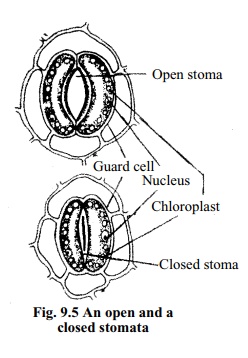Chapter: Biology: Physiological Activities in Plants Nutrition
Stomata: Process of Stomatal Tranpiration and Factors affecting
STOMATA:
Stomata are present in leaves, young stems, calyx and corolla of flower etc. a small pore encircled by two guard cells is called a Stoma. Cell walls of guard cells adjacent to stomata are thick but the walls on opposite side are thin. There present a large nucleus and many chloroplasts. The swelling and looseness of the guard cells regulate the opening and closing of stomata. When the guard cells swell up the stomata opens and when it looses the stomata closes. The ventral surface of dorsiventral leave bears more stomata.

Process of Stomatal Tranpiration :
Stomata are present on the leaf, usually on the ventral surface. At the upper epidermis of dorsiventral leaves there are palisade parenchyma and at the lower epidermis there are spongy parenchyma. In spongy parenchyma there are many air spaces. Stomata are present near the air space and placed on the lower epidermis. Usually vascular tissues i.e. xylem and phloem are present at the connecting zones of Palisade and Spongy parenchyma. Root hairs absorb water from soil and reach to the leaf through stem by vessels and Tracheids of xylem tissue. On reaching leaf the water come out of the xylem tissue and spread throughout all the cells of the leaf. The outer walls of the spongy parenchyma always remain wet to absorb carbon dioxide (CO2), necessary for photosynthesis. The air inside the air space of spongy parenchyma come in contact with water of spongy parenchyma and absorb water vapour and store in the air spaces behind the stomata. Later on the vapour come out to the atmosphere through the open stomata. Air, O2 and CO2 also moves through open stomata. In most plants stomata remain open during daytime and closed in night. In succulent plants stomata remain open at night and closed in daytime. As a result of photosynthesis the carbohydrates inside the guard cells converted to soluble glucose and the guard cells absorb water from adjacent cells and become turgid and the stomata opens. During night. the soluble glucose converted to insoluble carbohydrate, the guard cell loose water to the adjacent cells by exosmosis and become flaccid. As a result the stomata closes. For this reason transpiration takes place in daytime.

Factors affecting Transpiration :
Affecting factors of transpiration are of two types; External and Internal.
External Factors:
Light: Photosynthesis takes place in presence of light and as a result stomataopens. So light is the main factor, which influence transpiration
Temperature: With the increase of temperature water vapourises rapidly andincreased the humidity in the atmosphere. So temperature controls the rate of transpiration.
Relative Humidity: If relative humidity is less the water vapour holdingcapacity of the air decreases, therefore rate or transpiration decreases.
· Air Current: The air current disposes the saturated air (as a result oftranspiration), away from the plant and thus increases the rate of transpiration.
· Atmospheric pressure: Under low pressure water vapourise at lowtemperature. So if pressure decreases the rate of transpiration increases and ifpressure increases the rate of transpiration will decrease.
· Soil water: If availability of soil water is less the rate of transpiration willdecrease.
Internal Factors:
Root-Leaf Ratio: If the number and total surface area of leaves becomemuch less in comparison with root region (absorption region) the rate of transpiration will reduce.
Leaf area: The greater the leaf area, greater will be the rate of transpiration,and lesser the leaf area the lesser the rate of transpiration.
Internal surface of leaf: Thin cuticle, thin cell walls, exposed stomata, andwell-developed spongy parenchyma favour transpiration. On the other hand leaves those possesses thick cuticle, thick cell walls, well-developed palisade parenchyma, Sunken stomata etc. will reducd the rate of transpirations.
Importance of Transpiration :
Transpiration is important to plants. The importance of transpiration is discussed briefly: -
Ascent of water and cell sap: Transpiration creates a pull on the watercolumn in the xylem vessel (which is called transpiration pull); as a result the water absorbed by the root and cell sap goes upwards.
Conduction of water and minerals to leaves: water and minerals conductedto the leaves by transpiration pull. So water, necessary for photosynthesis and Mg, necessary for production of chlorophyll, conducted to leaves by transpiration. So it can be said that transpiration plays an indirect role on manufacturing food by photosynthesis.
Maintaining proper temperature and release of energy in leaf: Leaves aretaking energy from the sun every moment. Only 1 % of this energy is utilized in different reactions. The rest heat energy released by transpiration. If the temperature in leaf does not remain in optimum condition, all the organic activities would have been seized. So this is also a good aspect of transpiration.
Cell division and physical growth: Transpiration indirectly maintainsosmosis and thus keeps all the cells rigid. As a result it enhance cell division and development of the organ.
Resistance to Fungal infection: Due to transpiration there deposits certainhygroscopic salts on the leaf surface, which resists fungal infection.
Absorption of C02 for photosynthesis: Spongy mesophyll cells of leavesreceive C02 from air present in the air spaces, by diffusion. For this the outer layer of the spongy mesophyll should always be wet. The air inside the air spaces absorbs water from here and transpires through stomata.
Excess of transpiration may cause shortage of water in plant. So excess of transpiration is harmful to plants.
Related Topics